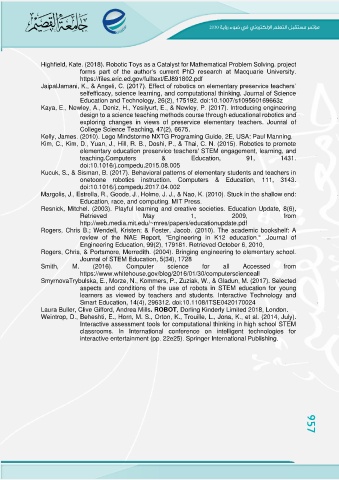Page 674 - Binder2
P. 674
2030
Highfield, Kate. (2018). Robotic Toys as a Catalyst for Mathematical Problem Solving. project
forms part of the author’s current PhD research at Macquarie University.
https://files.eric.ed.gov/fulltext/EJ891802.pdf
JaipalJamani, K., & Angeli, C. (2017). Effect of robotics on elementary preservice teachers’
selfefficacy, science learning, and computational thinking. Journal of Science
Education and Technology, 26(2), 175192. doi:10.1007/s109560169663z
Kaya, E., Newley, A., Deniz, H., Yesilyurt, E., & Newley, P. (2017). Introducing engineering
design to a science teaching methods course through educational robotics and
exploring changes in views of preservice elementary teachers. Journal of
College Science Teaching, 47(2), 6675.
Kelly, James. (2010). Lego Mindstorme NXTG Programing Guide, 2E, USA: Paul Manning.
Kim, C., Kim, D., Yuan, J., Hill, R. B., Doshi, P., & Thai, C. N. (2015). Robotics to promote
elementary education preservice teachers' STEM engagement, learning, and
teaching.Computers & Education, 91, 1431.
doi:10.1016/j.compedu.2015.08.005
Kucuk, S., & Sisman, B. (2017). Behavioral patterns of elementary students and teachers in
onetoone robotics instruction. Computers & Education, 111, 3143.
doi:10.1016/j.compedu.2017.04.002
Margolis, J., Estrella, R., Goode, J., Holme, J. J., & Nao, K. (2010). Stuck in the shallow end:
Education, race, and computing. MIT Press.
Resnick, Mitchel. (2003). Playful learning and creative societies. Education Update, 8(6),
Retrieved May 1, 2009, from
http://web.media.mit.edu/~mres/papers/educationupdate.pdf
Rogers, Chris B.; Wendell, Kristen; & Foster, Jacob. (2010). The academic bookshelf: A
review of the NAE Report, "Engineering in K12 education." .Journal of
Engineering Education, 99(2), 179181. Retrieved October 6, 2010,
Rogers, Chris, & Portsmore, Merredith. (2004). Bringing engineering to elementary school.
Journal of STEM Education, 5(34), 1728
Smith, M. (2016). Computer science for all Accessed from
https://www.whitehouse.gov/blog/2016/01/30/computerscienceall
SmyrnovaTrybulska, E., Morze, N., Kommers, P., Zuziak, W., & Gladun, M. (2017). Selected
aspects and conditions of the use of robots in STEM education for young
learners as viewed by teachers and students. Interactive Technology and
Smart Education, 14(4), 296312. doi:10.1108/ITSE0420170024
Laura Buller, Clive Gifford, Andrea Mills. ROBOT, Dorling Kinderly Limited 2018, London.
Weintrop, D., Beheshti, E., Horn, M. S., Orton, K., Trouille, L., Jona, K., et al. (2014, July).
Interactive assessment tools for computational thinking in high school STEM
classrooms. In International conference on intelligent technologies for
interactive entertainment (pp. 22e25). Springer International Publishing.
957

